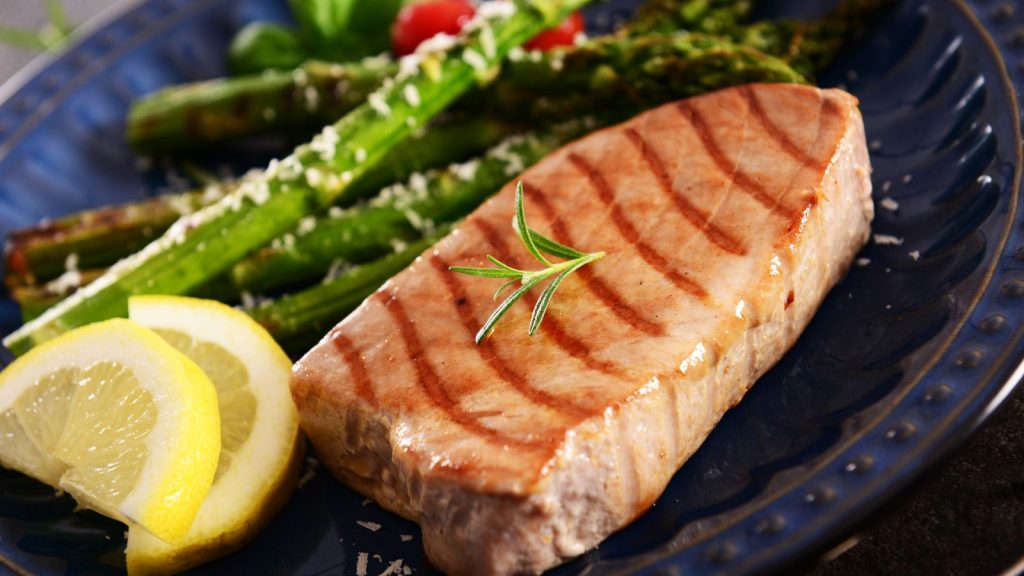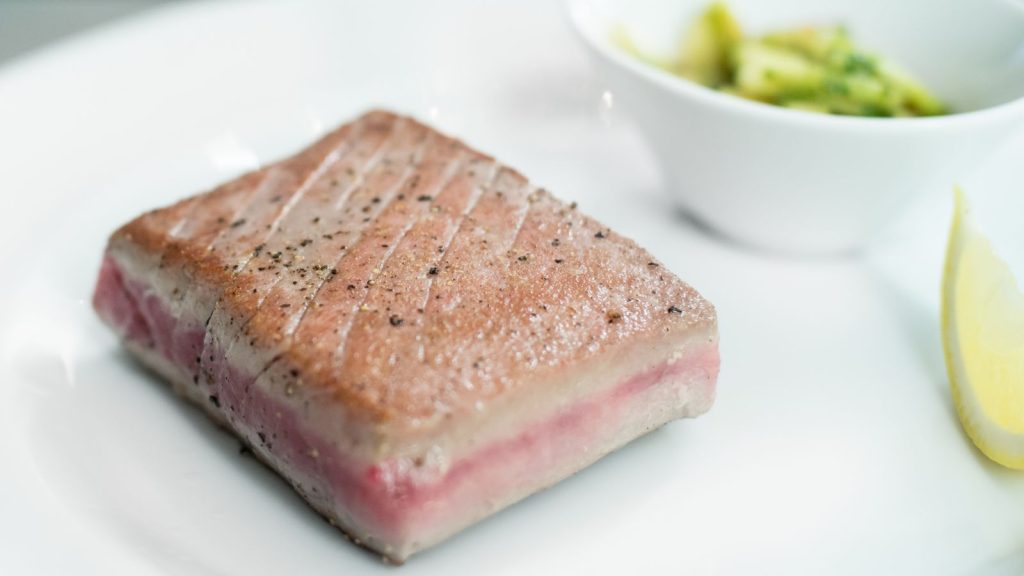Can you eat tuna steak raw? Are you one of those people who love sushi? Do you ever crave a nice, juicy tuna steak? If so, you’re in luck! You can enjoy both of those dishes without having to cook them. All you have to do is eat them raw.
Sounds great, right? Well, only some agree. Some people think that eating tuna steak or sushi raw is too risky. They say it’s full of harmful bacteria that can make you very sick. Is this true? Or are they just scaremongering? Keep reading to find out!
What is tuna steak and where does it come from?

Tuna steak is a popular and flavorful seafood delicacy. It is made from the flesh of tuna. Depending on the species, tuna can be found in every ocean worldwide. The most commonly used variety for tuna steaks is bluefin tuna.
It is prized for its mild yet distinct flavor and delicious fatty pearly pink flesh. When caught at a suitable size and kept iced until preparation, tuna steak makes an excellent restaurant dish or dinner party favorite.
When cooked correctly, it is tender with a subtly sweet taste cherished by diners throughout the centuries.
Is tuna safe to eat raw?
Those who choose to consume raw tuna must buy the freshest product possible. It means purchasing from a reputable source, such as a trusted fishmonger or high-end grocery store.
The fish should have an opaque color and smell fresh—never use frozen tuna in sushi dishes! Freezing the fresh filets at -4°F for 7 days before consumption will help kill parasites that may be present in the fish.
How do you prepare tuna steak for consumption?
To prepare tuna steak for consumption, choose fresh-caught tuna at your local fish market or grocery store.
- Make sure to check the labeling on the packaging, as some types of tuna have higher levels of mercury than others.
- Once you have selected the right tuna, rinse it thoroughly with cold water before patting it dry with paper towels.
- Then season the steak with salt and pepper before cooking it according to your preference.
- Grilling or searing are great options for preparing this type of fish.
Finally, ensure the internal temperature reaches 145 degrees Fahrenheit (or 63 degrees Celsius).
What are the health benefits of eating tuna steak?
- Tuna steak contains high omega-3 fatty acids essential for good heart health and cognitive development.
- These fatty acids help to reduce inflammation in the body while also reducing cholesterol levels. Additionally, they can help to protect against cardiovascular disease and stroke.
- Tuna steaks are also a great source of protein, providing energy and helping build muscle strength.
- They are low in calories but rich in nutrients like vitamin B12 and selenium. It helps boost metabolism and promote healthy skin, hair, and nails.
Are there any risks associated with consuming raw tuna steak?
Raw tuna steak is an increasingly popular menu item in sushi restaurants, and certain health benefits are associated with eating raw fish. There are also potential risks that one should be aware of before consuming this delicacy.
- Raw tuna steak may contain parasites or bacteria that can cause foodborne illness if not properly handled and prepared.
- These pathogens include Anisakis simplex worms, which can cause serious digestive problems if left untreated.
- Moreover, consuming too much mercury-contaminated fish may increase one’s risk for neurological damage and other diseases.
For these reasons, it is best to consult a healthcare professional before partaking in raw tuna steaks or another sushi dish to ensure safety.
Recipes that include raw tuna steak as an ingredient

Raw tuna steak is a versatile ingredient that can be used to make many different types of dishes. From simple salads to more complex entrées, these recipes offer plenty of flavor and nutrition. Here are some popular recipes that include raw tuna steak as an ingredient.
The first recipe is for Tuna Poke Bowls. This Hawaiian-inspired dish consists of diced raw tuna mixed with sesame oil, soy sauce, green onions, and sesame seeds, served over steamed white rice and topped with avocado slices.
The second recipe is for spicy seared tuna tacos with lime crema drizzle on top. The tacos feature seared rare tuna seasoned with chili powder and garlic powder wrapped in soft tortillas and shredded cabbage and mango salsa.
Tips for cooking and preparing tuna steak safely
First, ensure that the tuna steak is cold before cooking. Refrigerate the steaks until ready to use, or purchase already-frozen steaks whenever possible. It will help prevent bacteria growth that could lead to food poisoning.
Before you start cooking, wipe down any surfaces that have come in contact with the raw fish with a mild bleach solution or another disinfectant cleaner.
Second, when you’re ready to cook, preheat your oven or grill according to instructions so that it is hot enough for proper cooking temperatures (at least 145°F).
Cooking Vs Eating Raw Tuna
Pros of Cooking Tuna
- Cooking tuna can kill any bacteria that may be present in the raw fish.
- Cooking tuna allows different flavor combinations and recipes to create a more interesting dish.
- It allows for easier digestion since raw tuna is tough to chew.
- It can help retain some of the nutritious elements in the fish, such as omega-3 fatty acids and proteins.
- Cooking tuna gives it a better texture and tastes better than raw tuna.
Cons of Cooking Tuna
- Overcooking tuna can cause it to become dry or rubbery.
- Longer cooking times can reduce some of the beneficial nutrients in the fish, such as Omega-3 fatty acids, proteins, and vitamins B12 and D3.
- Some recipes may call for unhealthy ingredients and additives, which can potentially increase sodium intake or add trans fats to your diet.
Eating Raw Tuna
Pros
- Eating raw tuna is an excellent source of omega-3 fatty acids, protein, and other essential vitamins and minerals.
- Raw tuna has a delicious flavor.
- It is quick and easy to prepare.
- It can be served as a nutritious meal or snack.
- Raw tuna is an excellent way to use fresh fish that would otherwise go to waste.
Cons:
- There is a risk of foodborne illness when eating raw tuna if it has not been properly handled or stored.
- Depending on the country, there may be regulations regarding selling raw fish for health reasons and safety concerns.
- Eating raw tuna can expose you to toxins that accumulate in fish from environmental pollutants like mercury and lead, which can have adverse health effects in high doses over time.
- Raw fish can contain parasites that may cause infection if not destroyed by thorough.
Is it safe to eat tuna steak rare?

When it comes to consuming raw or undercooked seafood – including tuna steaks – the risk of contracting foodborne illnesses increases significantly. While this doesn’t mean you should never eat rare tuna steak, it requires extra caution due to potential health risks.
If you choose to eat rare tuna steak, make sure the fish is fresh and of high quality. In addition, be sure to store and prepare it properly to reduce the risk of contamination as much as possible.
Can tuna steak give you food poisoning?
Tuna has the potential to host bacteria such as salmonella and listeria. It can lead to symptoms of food poisoning, such as nausea, vomiting, abdominal cramps, fever, and diarrhea. Furthermore, raw consumption puts people at the highest risk of contracting an illness due to exposure to these harmful contaminants.
Therefore it’s imperative that proper safety measures be taken when handling or consuming raw tuna products to prevent any potential contamination from occurring.
Can tuna steak be eaten pink?
You can safely eat tuna steaks with a pink center as long as they have been properly cooked and stored. The best way to ensure your tuna steak has been cooked correctly is by using a digital thermometer and checking for an internal temperature of 145°F (62°C).
If you don’t have access to a thermometer, look for any signs of discoloration or dryness on the outside – this usually indicates that the inside will also be overcooked.
Can you eat tuna steak raw in the middle?
Generally, sushi-grade tuna is the preferred choice for raw consumption due to its freshness and lower risk of contamination. If you are using other types of fresh or canned tuna, remember that they haven’t been treated to remove parasites or bacteria.
There is an increased risk associated with eating them raw. To reduce this risk further, ensure that any fish used for sushi has been frozen at temperatures below -4°F (-20°C) for at least 7 days before consuming it.
Can you eat tuna raw without freezing it?
Eating raw tuna frozen at a temperature of -31°F or lower for 15 hours is generally considered safe. This process kills parasites that may be present, making the fish safe to consume.
However, if freezing isn’t an option, there are other ways to ensure your raw tuna is safe to eat. You should always purchase from a reputable source and ensure the fish is fresh and not past its expiration date.



